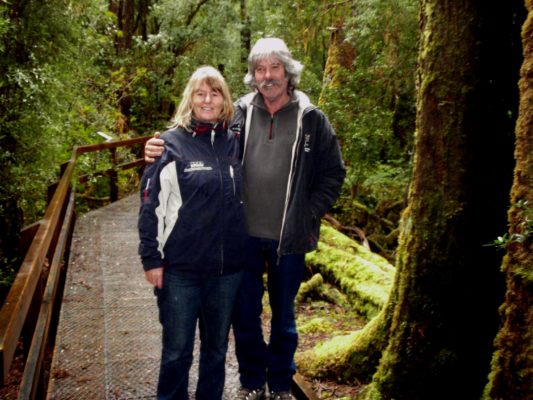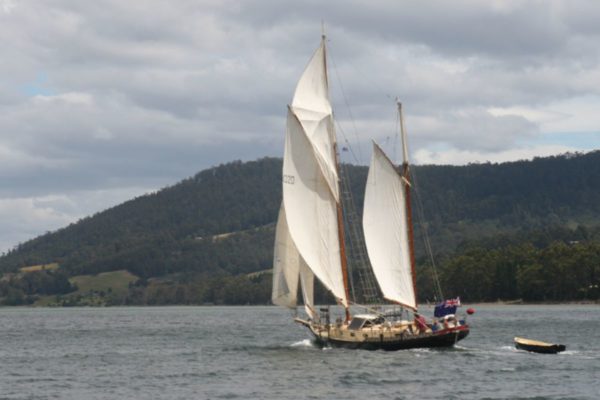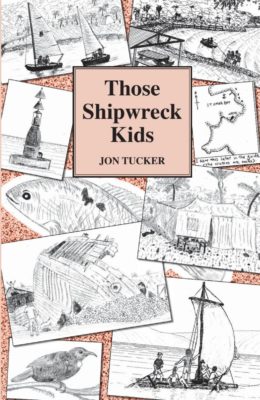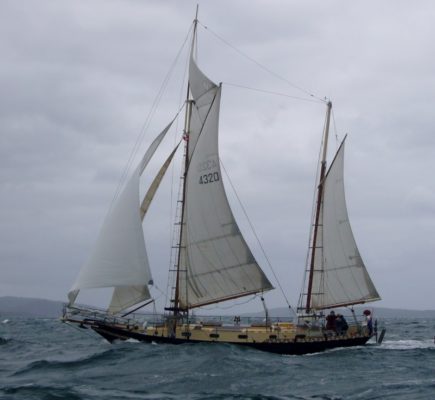‘When children’s author, Jon Tucker, was a teenager growing up in Nelson, he married the girl next door and they began to build a boat together; not just a dinghy or small sailboat, but an “old-fashioned, romantic” traditional ketch that they named ‘New Zealand Maid’.

Jon and Babs later became teachers and had five sons – but the suburban life was not for them. They wanted to do as much sailing as they could with their boys, so they gave up their house and teaching jobs to live aboard their ketch full-time.

Their sons grew up sailing around New Zealand, Australia and the South Pacific, exploring, having adventures, doing their lessons by correspondence and learning a whole lot more than schoolwork along the way. They learnt independence, resilience, responsibility, confidence and problem-solving, skills you don’t have much opportunity to learn if your only adventures are computer games.
Jon and Babs were to live aboard ‘New Zealand Maid’ for much of the next 30 years.
It’s that adventurous lifestyle and independent spirit, kids getting outdoors and doing stuff, that Jon captures in the series of children’s books that he is now writing. The books very much reflect the adventures that his own family had growing up.
‘Those Shipwreck Kids’, the third book in the series, has just been published and has a predator-free environmental theme. It’s set in an area that Jon and Babs know well – back home in the Marlborough Sounds, and should appeal to children from age nine years up to their early teens.
“We sailed back to the Sounds last year and spent eight months there, researching and writing ‘Those Shipwreck Kids’,” says Jon.

Babs does lots of research for the books and also takes the photographs for articles Jon writes. As well as writing, Jon also illustrates his children’s novels, even though he describes himself as “crap at drawing”. He believes that illustrations are important to help kids get into reading books.
“Getting kids into reading is so important,” Jon says. “These books have short chapters, so they’re good for reluctant readers. Each chapter is about 2000-2200 words which is a readable length for kids. It’s also a good size for a teacher to read to class – it takes about 20-25 minutes to read a chapter. A lot of teachers are reading the book aloud to promote discussion,” he adds.
‘Those Shipwreck Kids’, like the previous two books in the series, is an adventure story with an environmental theme and, when environmental issues are encountered in the story, Jon has been careful and meticulously fair in presenting multiple points of view. He hopes to increase his readers’ awareness of issues, provide them with information and allow them to form their own opinions.
“It’s good to write things into a book so that it’s part of a learning process, without ramming it down their throats,” Jon explains. “I try to weave into the book as many viewpoints as possible. It’s woven into the thread of an adventure story. Kids need the chance to make up their own minds.”
Not all the characters in Jon’s novels are fictional.
“Taffy was a real character. He’s dead now, but he was living in the Sounds on an old boat when we were there with our five boys in the early 1990s. He was a possum hunter who used to wax very prolifically against the 1080 drops. I haven’t changed his character much.”
Jon and Babs have always been very environmentally aware. Back in the 1990s when Greenpeace and the anti-nuclear movement organised a flotilla of New Zealand protest boats to sail to Mururoa Atoll, they looked at each other and knew they had to go.
“We joined a dozen boats from New Zealand,” Jon says. “Three of our sons came along as crew and we stayed outside the 12 mile exclusion zone. A French navy boat came alongside us and gave us a message, but we didn’t let them onboard with weapons.”
After 30 years of living aboard ‘New Zealand Maid’, with their sons now all grown, Jon and Babs bought a block of land on an island off the Tasmanian coast.
“We planted 1000 bird-attracting trees and then found we had the 40-spotted pardalote living on our land. It’s one of Australia’s rarest birds,” Jon says proudly.

But after 13 years in Tasmania, Jon and Babs are now back living in New Zealand..
“It was great coming back and hearing more birdlife than when we left,” Jon says, “Especially in the Marlborough Sounds. And last year when we sailed from Tasmania to Stewart Island, it was amazing to hear the Ulva Island birdsong.”
Currently ‘New Zealand Maid’ is anchored in the Bay of Islands and Jon and Babs are loving it there.
“We’ll spend all winter and most of summer in the Bay of Islands,” Jon says. “The boat is our home again now.”
Jon and Babs are currently researching the fourth book in Jon’s children’s series which will have a global warming and rising sea levels theme – as well as being another rollicking good, modern-day Arthur Ransome-style children’s adventure. A further two books are planned for the series after that.
Jon will also be promoting his book over the next few months, giving talks in Christchurch and Oamaru and visiting schools.
“We’re both ex-teachers,” he says. “It’s a nice feeling going back into schools, particularly smaller, remote schools which love visitors, like one in the Marlborough Sounds we’re going to visit, near where ‘Those Shipwreck Kids’ is set.”
So if you know of a youngster who would enjoy a good adventure story, keep an eye out in for Jon’s series of sailing books. They’re great yarns with an informed environmental theme and written by someone who has genuinely lived the adventurous seaboard life.

